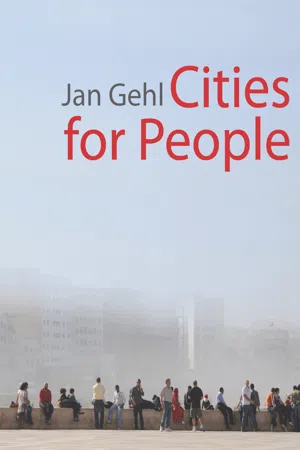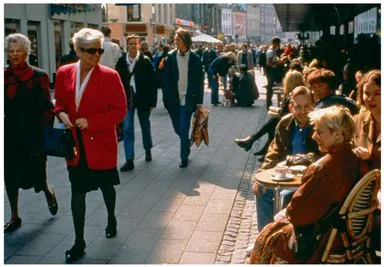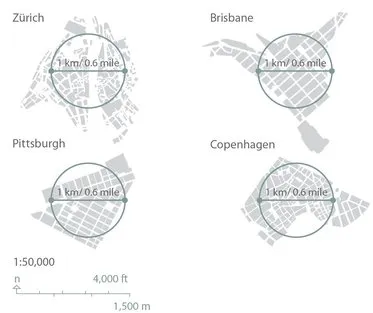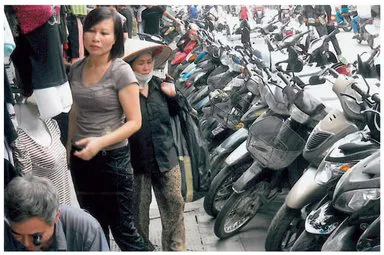4.1
The battle for quality is on the small scale
the city at eye level — the most important scale for city planning
In many cities, particularly those in developing countries, a great deal of pedestrian traffic is generated by nessisity. In other parts of the world, the number of pedestrians depends entirely on the extent to which people are invited to walk.
City quality is important regardless of whether foot traffic is a question of necessity or invitation. Good city quality at eye level should be considered a basic human right wherever people go in cities.
It is on the small scale, in the 5 km/h (3 mph) urban landscape, that people encounter the city close up. It is here that the individual out walking has time to enjoy quality — or suffers from its lack.
Regardless of planning ideologies and economic prerequisites, careful management of the human dimension in all types of cities and urban areas should be a universal requirement.
walking, standing, sitting, listening and talking — a good place to start
The following is an overview of the principles for human dimension planning in cities. The starting point is simple: universal human activities. Cities must provide good conditions for people to walk, stand, sit, watch, listen and talk.
If these basic activities, which are tied to the human sensory and motor apparatus, can take place under good conditions, these and related activities will be able to unfold in all possible combinations in the human landscape. Of all the city planning tools available, attention to this small scale is the most important.
If the living room in a home does not work for its owner on a daily basis, a carefully planned city or housing complex will be of little comfort. In contrast, the quality of a dwelling and city space at eye level can in itself be decisive to everyday quality of life despite deficiencies in other planning areas.
Consideration for people’s direct senses is crucial to whether they can walk, sit, listen and talk inside buildings, in the neighborhood or in town. The battle for quality is on the small scale.
4.2
Good cities for walking
It is a big day when at about one year of age a child takes its first step. The child’s eye level moves from the vantage point of the crawler (about 30 cm/1 foot) above the floor to about 80 cm/2.6 feet.
The little walker can see much more and move faster. From now on everything in the child’s world — field of vision, perspective, overview, pace, flexibility and opportunities — will move on a higher, faster plane. All of life’s important moments will hereafter be experienced on foot at standing and walking pace.
While walking is basically a linear movement that brings the walker from place to place, it is also much more. Walkers can effortlessly stop underway to change direction, maneuver, speed up or slow down or switch to a different type of activity such as standing, sitting, running, dancing, climbing or lying down.
Life takes place by foot (Lucca, Italy; Amman, Jordan; and Marrakesh, Morocco).
There is more to walking than walking.
walking with a purpose — and as beginning
A city walk illustrates its many variations: the quick goal-oriented walk from A to B, the slow stroll to enjoy city life or a sunset, children’s zig-zagging, and senior citizens’determined walk to get fresh air and exercise or do an errand. Regardless of the purpose, a walk in city space is a “forum” for the social activities that take place along the way as an integral part of pedestrian activities. Heads move from side to side, walkers turn or stop to see everything, or to greet or talk with others. Walking is a form of transport, but it is also a potential beginning or an occasion for many other activities.
Many factors impact on walking speed: the quality of the route, the surface, the strength of the crowd, and the age and mobility of the walker. The design of the space also plays a role. Pedestrians usually walk faster on street that invite linear movement, while their pace falls while traversing squares. It is almost like water, which flows rapidly along riverbeds but moves more slowly in lakes. Weather is another factor. People move more quickly when it is raining, windy or cold.
On Copenhagen’s main walking street, Strøget, pedestrian traffic on cold winter days is 35% faster than on good summer days. In summer there are many pedestrians in the city promenading and enjoying the process, while pedestrian traffic in winter is considerably more targeted. When it’s cold, people walk for warmth. On average the walking speed in summer is 14.2 min per km/23 min per mile, corresponding to 4.2 km per hour/2.6 mph. Corresponding winter walking speeds are 10.3 min per km/16.6 min per mile corresponding to 5.8 km per hour/3.6 mph.1
A walk of 450 m/0.3 mile takes about five minutes, while a walk of 900 m/0.6 mile will take about 10 minutes at 5.4 km per hour/3.4 mph. Naturally, these time estimates are only valid if the area is uncrowded and people can walk without obstacles or breaks.
An acceptable walking distance is a relatively fluid concept. Some people happily walk many kilometers/miles, while even short walks are difficult for old people, the disabled and children. Walks of 500 m/0.3 miles are mentioned frequently as a distance most people are willing to walk. However, an acceptable distance also depends on the quality of the route. If the pavement is good quality and the route interesting, a considerably longer walk is often acceptable. Conversely, the desire to walk drops drastically if the route is uninteresting and thus feels tiring. In that case a walk of only 200 or 300 m/0.12 to 0.18 mile will seem like a long way, even if it only takes less than five minutes on foot.2
A distance of 500 m/0.3 mile as an approximate goal for acceptable walks is supported by the size of city centers. By far the majority of city centers are about one km2/0.39 sq mile, corresponding to an area of 1x1 km/0.6 x 0.6 mile. This means that a walk of a kilometer or less will bring the pedestrians around to most of the functions in the city.
Huge cities like London and New York have corresponding patterns, as they are divided into numerous centers and districts. The magic one km2 center size can certainly be found in these cities. The acceptable walking distance does not change just because the city is larger.
An important prerequisite for a comfortable and pleasurable walk is room to walk relatively freely and unhampered, without having to weave in and out and without being pushed and shoved by others. Children, older people and people with disabilities have special requirements for being able to walk unhindered. People pushing strollers, shopping carts and walkers also need plenty of room for walking. Groups of young people are typically the most tolerant about moving about in crowds.
Most city centers measure one square km/0.39 square mile, which enables pedestrians to reach all important city functions by walking one kilometer / 0.6 mile or less.
This street sign in Poland discreetly recommends that people keep their arms close to their sides.
The high priority given to car traffic and parking have created unreasonable conditions for pedestrians all over the world.
Enough space for walking is important to all groups of pedestrians, but especially children, the elderly and the disabled.
If we look at photographs from 100 years ago, pedestrians are often shown moving freely and unimpeded in every direction. Cities were still primarily the province of pedestrians, with horse-drawn carriages and trolleys and a few cars merely as visitors.
In step with the car invasion, pedestrians were first pushed up along building façades and then increasingly squeezed together on shrinking sidewalks. Crowded sidewalks are unacceptable and a problem worldwide.
Studies of urban streets in London, New York and Sydney illustrate the problems of narrow sidewalks for large crowds of pedestrians on streets where most of the area is designed for car traffic, despite the fact that the number of drivers is far lower than the number of pedestrians crowded together on the sidewalk.3
The pedestrian traffic on sidewalks moves in columns that are pushed and shoved, and everyone must move at the speed dictated by the pedestrian stream. The elderly, the disabled and children cannot possibly keep up.
Various limits are suggested for what is considered an acceptable amount of space for pedestrian traffic, depending on context. Based on studies in New York, William H. Whyte proposes up to 23 pedestrians per minute per meter/three feet on the sidewalk. Studies in Copenhagen propose 13 pedestrians per minute per meter/three feet of sidewalk, if the limit for unacceptable crowding on sidewalks is to be avoided.4
If walking is to be comfortable, including acceptable distance and pace, there has to be room to walk without too many interruptions and obstacles. These qualities are often offered in dedicated pedestrian areas, but seldom on sidewalks on city streets. On the contrary, it is impressive to note how many obstacles and difficulties have been incorporated into pedestrian landscapes over the years. Traffic signs, lampposts, parking meters and all types of technical control units are systematically placed on sidewalks in order “not to be in the way.” Cars parked on or partially on sidewalks, thoughtlessly parked bicycles and undisciplined street displays complete the picture of a pedestrian landscape where pedestrians have to maneuver like skiers down a slalom course in order to move along sidewalks that ar...






